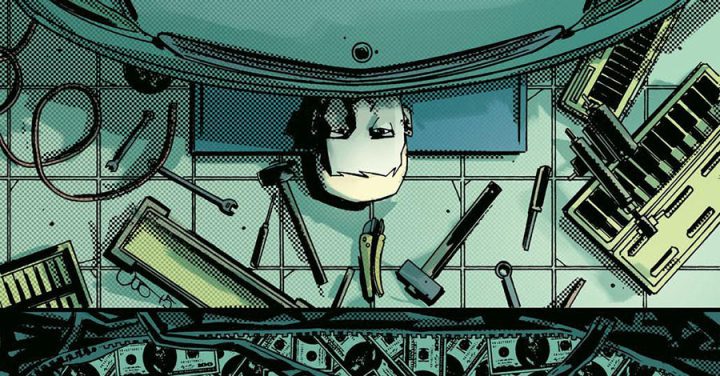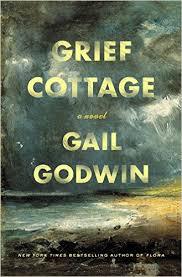By Hazel Romano | June 20, 2017
Behind the wheel of a vintage car, an unassuming man waits patiently outside a building. The flickering shop signs along the dim streets of downtown LA are all that’s left of the day’s remains. Sunlight is falling and fading quickly now, its hues of yellow and orange melting subtly into an indigo blanket of shadows.
 Credit: Michael Benedetto & Antonio Fuso, Drive / IDW
Credit: Michael Benedetto & Antonio Fuso, Drive / IDW
Such is the tone prevalent throughout the comic adaptation of James Sallis’ 2005 novella Drive, a thrilling neo-noir crime drama which centers on the life of an anonymous man. A Hollywood stunt driver by day, the Driver engages in more illicit activities by night as a getaway driver for some of the town’s most nefarious hitmen. After meeting with a new client named Cook, the Driver soon finds himself in a situation that quickly spirals dangerously out of control.
Like the sunsets that descend on LA’s horizons, the rich atmosphere of the neo-noir style permeates the series. A throwback ode to the 40’s and 50’s psychological crime genres, Drive abandons an unromanticized view of urbanity in favor of cold anti-heroes and searing nihilism.
 Credit: Michael Benedetto & Antonio Fuso, Drive / IDW
Credit: Michael Benedetto & Antonio Fuso, Drive / IDW
Content with his anonymous and detached lifestyle, the Driver prides himself on a lack of identity. He never states his name, making him resemble more of an outline of a character than a brooding, full-fledged anti-hero. A closed-lip middle-man who facilitates events rather than participates in them, his primary interest involves blending into his background and abiding by a day-to-day schedule dictated by his pragmatism. The murky motivation behind his philosophical imperative is blunt and succinct: ”You tell me where we start, where we’re headed, what time of the day. I don’t take part. I don’t know anyone. I don’t carry weapons. I drive. […] It’s not attitude. It’s principle.”
Utilizing striking and stylistic illustrations, the adrenaline-pumping car chases mark a steely edge against the pastel background. The color palette employs contrast between bold colors such as magenta, teal, and orange with black and blue to evoke the grimy bleakness of the criminal underworld. Bar scenes are awash with hot pink, while light and shadows serve to diffuse the tension in conversations, paralleling the jolted, edge-of-your-seat action and graphic violence that punctuates throughout the story.

It’s the series’ overall defiance of convention that surprises readers. What you expect is a secondary character, the getaway driver whose only job is to stay out of business and stay on the sidelines. Here is a story that flips that outdated script. The Driver holds positions in two worlds: one in which he presents a veneer of chaos, wherein the other he keeps a firm grip on controlled disarray. Though he’s relegated to a spectator at most, he revels in his work with stride and cynicism: ”Someone should tell them, that’s what life is.. a long series of things that don’t go down the way you thought they would.”
That’s exactly the kind of unexpected obstacle the Driver is confronted with. After developing an attachment towards a woman named Irina and her son Benicio, the Driver is forced to compromise his own bystander code. The acts of abrupt violence he commits make readers wonder whether if they are watching a man acting out of desperation or a beast awakening from its dormancy. What is it about Irina and her son that draws him to them? His sudden protective instinct is just as shocking as the desperate and hyper-violent moves he makes.

The series presents Los Angeles almost as a kind of character. Drive’s restraint towards plot complexity is made up by its omniscient presence. The sprawling city is ground zero for criminal dealings and illegitimacy. “LA becomes a different beast by night,” notes the Driver, commenting on how people’s personas take on an indecent transition as their days wind down. Readers are plunged into an environment where dysfunction and immorality thrives.
Drive’s stripped down simplicity and its bare-bones plot delivers an unrelenting gut punch. Without relying on gimmicks, the series beholds a viciousness and velocity which arrests the reader’s attention the entire time. Despite minimal characters and dialogue, the series showcases visceral storytelling through a tightly-contained narrative. Once it starts, the Driver’s one-track mind never slows, leaving audiences to question whether the Driver is a victim or by-product of the city he so scathingly critiques.
Read Drive on ComicBlitz
 Image / Banner: Emilie Vo
Image / Banner: Emilie Vo


Hazel Romano is a freelance writer and recent UC Berkeley grad. When she’s not geeking out over fantasy and sci-fi movies, she likes to travel and spend time with her furbabies, Remus and Noah. You can see more of her work at wiltedink.wordpress.com.
Advertisements Share this:




